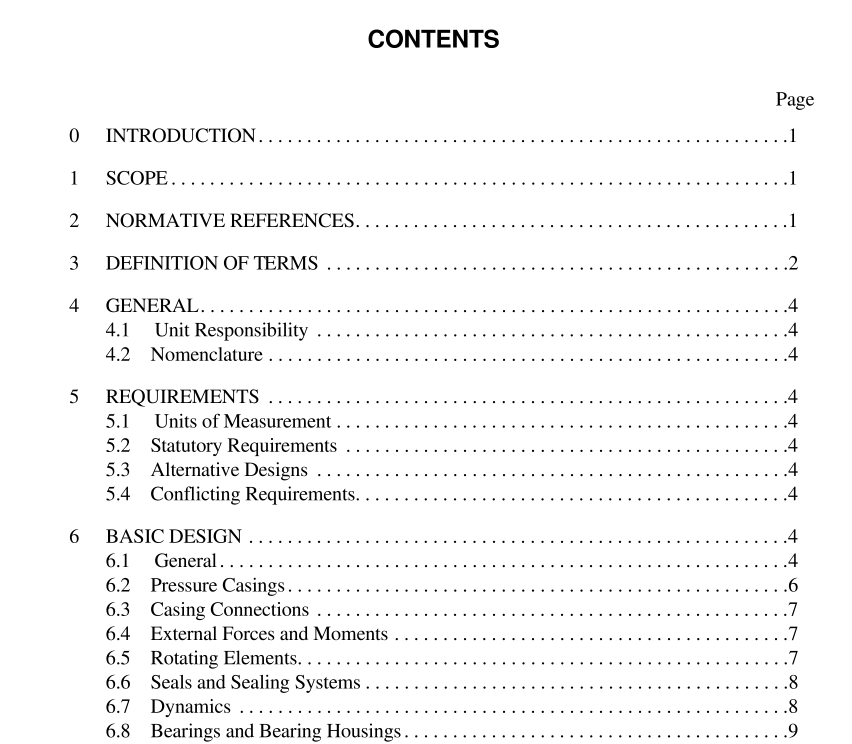API STD 672 pdf download

API STD 672 pdf download.Packaged, Integrally Geared Centrifugal Air Compressors for Petroleum, Chemical, and Gas Industry Services
1 Scope
1.1 This standard covers the minimum requirements for constant-speed, packaged, general purpose integrally geared centrifu- gal air compressors, including their accessories. This standard is not applicable to machines that develop a pressure rise of less than 0.35 bar (5.0 psi) above atmospheric pressure, which are classed as fans or blowers. Note: Special Purpose and Process applications, including Process Air Services, are covered by API Std 617. 1.2 Equipment covered by this standard is considered non-critical, usually spared and may be either of two classifications, Basic or Special Duty. The purchaser shall specify which of the two classifications applies. Basic packages are vendors’ standard packages of proven design and include minimal additional requirements. Special duty packages are typically specified for installations that require higher availability and include additional features and requirements. 1.3 Additional or overriding requirements applicable only to packages that have been specified as “Special Duty” are noted at the end of each section (see 6.12; 7.10; 8.5; and 9.4). 1.4 Conflicting Requirements In case of conflict between this standard and the inquiry, the inquiry shall govern. At the time of the order, the order shall govern.
2 Normative References
2.1 Reference publications are listed in Annex B. 2.2 All referenced standards, to the extent specified in the text, are normative.2.3 The editions of the Annex B standards, codes, and specifications that are in effect at the time of publication of this standard shall, to the extent specified herein, form a part of this standard. The applicability of changes in standards, codes, and specifications that occur after publication of this document shall be mutu- ally agreed upon by the purchaser and the vendor. 2.4 Notes following a paragraph are informative. 2.5 Where dual referencing of standards occurs, the system of standards to be used shall be specified. 2.6 Statutory Requirements: The purchaser and the vendor shall mutually determine the measures that must be taken to comply with any governmental codes, regulations, ordinances, or rules that are applicable to the equipment.
3 Definition of Terms
Terms used in this standard are defined in 3.1 – 3.36. 3.1 alarm point : A preset value of a parameter at which an alarm is actuated to warn of a condition that requires corrective action. 3.2 axially split: A joint that is parallel to the shaft centerline. 3.3 bearing housing: All bearing enclosures, including the gear casing. 3.4 critical speed: A shaft rotational speed at which the rotor-bearing-support system is in a state of resonance. 3.5 delivered flow: The flow rate determined at the compressor discharge or after the discharge of the aftercooler when included in the vendor scope. Note: When the flow is measured before the compressor inlet, it must be adjusted for the effects of aftercooler pressure drop, compressor seal losses, and interstage condensate removal. 3.6 design: A term that may be used by the equipment manufacturer to describe various parameters such as design power, design pressure, design temperature, or design speed. Note: This terminology should be used only by the equipment manufacturer and not in the purchaser’s specifications. 3.7 gear wheel (bull gear): The low-speed rotor of a gear set. 3.8 informative element: Describes part of the standard which is provided for information and is intended to assist in the understanding or use of the standard. Compliance with an informative part of the standard is not mandatory. Note: An Annex may be informative or normative as indicated. 3.9 inlet volume flow: The flow rate expressed in volume flow units at the conditions of pressure, temperature, compressibil- ity and air moisture content, at the compressor inlet connection. 3.10 local: The location of a device mounted on or near the equipment or console. 3.11 material certificate of compliance: A document by which the vendor certifies that the material represented has been produced and tested in accordance with the requirements of the basic material specification shown on the certificate. 3.12 maximum allowable temperature: The maximum continuous temperature for which the manufacturer has designed the equipment (or any part to which the term is referred) when handling the specified fluid at the specified maximum operating pressure. 3.13 maximum allowable working pressure: The maximum continuous pressure for which the manufacturer has designed the equipment (or any part to which the term is referred) when handling the specified fluid at the specified maximum operating temperature. 3.14 maximum discharge pressure: The maximum suction pressure plus the maximum differential the compressor is able to develop to surge at the minimum specified inlet temperature. 3.15 maximum sealing pressure: The highest pressure the seals are required to seal during any specified static or operating condition.









